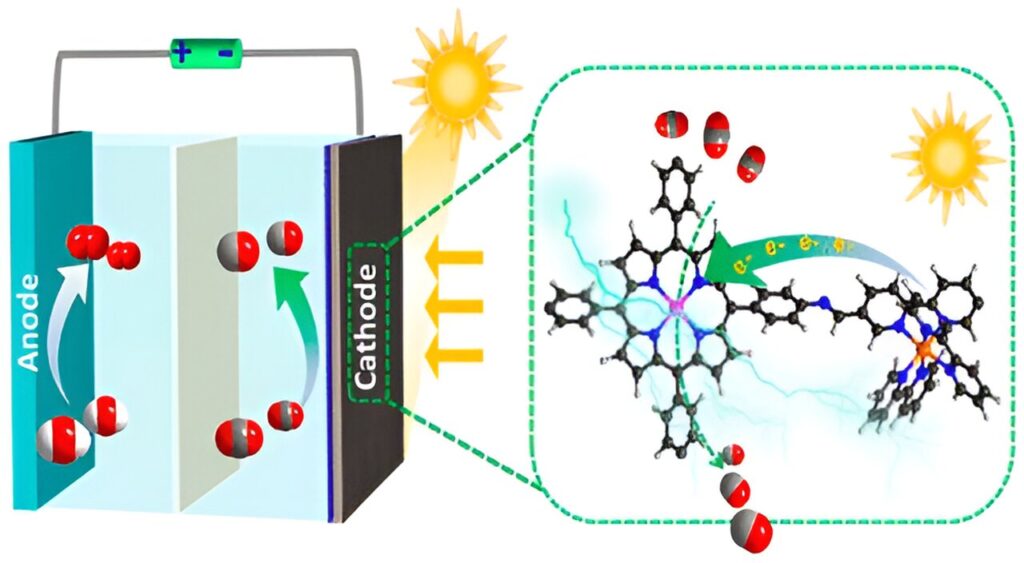
Electrocatalytic CO2 reduction reaction (CO2RR) is thought to be an ecologically favorable technique to use CO2 as a cheap and abundant C1 feedstock for the production of value-added chemicals such as CO. However, the thermodynamically stable nature of CO2 molecule featuring high C=O bond energy frequently leads to sluggish kinetics of CO2→CO and high energy inputs.
Introducing an additional visible-light field will be a potential way to explore the optimized reaction conditions and develop effective catalysts for the efficient CO2RR towards CO, as the highly energetic photo-induced excited state of light-sensitive electrocatalysts can effectively optimize the formation barrier of reactive intermediates and lower the energy of the rate determining steps (RDS) of electrocatalytic CO2RR. The efficient excited state lifetime of the active site is an important influencing factor in visible photocoupled electrocatalysis.
In a study published in Journal of the American Chemical Society, a group led by Prof. CAO Rong and Prof. HUANG Yuanbiao from Fujian Institute of Research on the Structure of Matter of the Chinese Academy of Sciences incorporated the Ru(bpy)3Cl2 photosensitive donors into a 2,2’-bipyridine functionalized Co-porphyrin-based COF (Co-Bpy-COF) by a post-synthetic method (PSM), providing Co-Bpy-COF-Rux (X is the molar ratio of Ru and Co speices, X = 1/2 and 2/3) with longer excited state lifetime for CO2 reduction under photo-electric conditions. Donor–acceptor characteristic and giant built-in electric field in Co-Bpy-COF-Rux efficiently accelerate the photo-induced electron transfer from Ru(bpy)3Cl2 to the cobalt porphyrin under the external light.
The researchers found that compared with the unmodified counterpart Co-Bpy-COF, the optimal Co-Bpy-COF-Ru1/2displays high CO Faradaic efficiency of 96.7% at -0.7 V vs reversible hydrogen electrode (RHE) and CO partial current density of 16.27 mA cm-2 at -1.1 V vs RHE under the assistance of light, both of which were far surpassing the values observed in the dark. Nonetheless, for Co-Bpy-COF, the values of FECO and jCO tested in the light displayed no significant improvement than those recorded in the dark, which could be attributed to the rapid relaxation of the excited state in the mono-photosensitive unit system.
Besides, the researchers revealed the trend of excited-electron transfer from Ru(bpy)3Cl2 to cobalt porphyrin by highest occupied molecular orbital (HOMO) and lowest unoccupied molecular orbital (LUMO) of the building units. The fluorescence quenching experiment and X-ray photoelectron spectroscopy (XPS) under the visible light further confirmed the real existence of excited-electron transfer from Ru(bpy)3Cl2 to cobalt porphyrin.
Furthermore, the researchers verified the formation of giant built-in electric field in Co-Bpy-COF-Rux by electrochemical impedance spectroscopy (EIS) and conductivity measurements. Ultrafast transient absorption (TA) spectra indicated that powerful donor (Ru(bpy)3Cl2) and giant built-in electric field dramatically extend the excited state lifetime of cobalt-porphyrins up to 3.4 times higher than the unmodified counterpart Co-Bpy-COF. The effect of external light irradiation lowering the energy barrier to the formation of CO was verified by the Tafel slopes and density function theory (DFT) calculations.
This study focuses on extending long excited state lifetime of photo-coupled electrocatalysts for efficient CO2RR to CO products, and provides a guideline for the development of efficient photocoupled electrocatalysts.
Author
LIU Jia
Source
Chinese Academy of Sciences, press release, 2023-09-08.
Supplier
Chinese Academy of Sciences (CAS)
Share
Renewable Carbon News – Daily Newsletter
Subscribe to our daily email newsletter – the world's leading newsletter on renewable materials and chemicals













